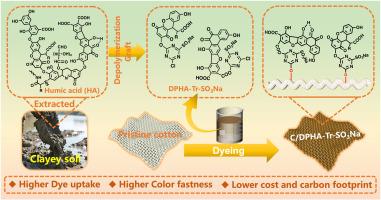从土壤腐植酸中提取的活性染料用于纤维素织物的高效染色
IF 4.2
3区 工程技术
Q2 CHEMISTRY, APPLIED
引用次数: 0
摘要
将生物质废弃物转化为高性能纺织染料,既有利于环境保护,又有利于纺织工业的绿色可持续发展。我们提出了一种新的策略,将腐植酸(HA)从土壤中更清洁地转化为低分子量和水溶性活性染料,通过解聚然后接枝氯三嗪和磺酸基团。综合分析(FTIR, NMR和GPC)证实了最终产物DPHA-Tr-SO3Na染料的成功合成。对其染色机理和性能的研究表明,DPHA-Tr-SO3Na具有活性染料的典型特征。在最佳染色条件下(pH值10、90°C、25 g/L NaCl、4% owf), dpa - tr - so3na在棉织物上的染色性能与商用合成染料相当:耗损率(86.1%)、固色率(70.0%),耐洗涤、摩擦和阳光照射的色牢度(4 - 5级)良好。最重要的是,细胞毒性测试证实了染料在纺织品应用中的高度安全性。此外,与普通合成活性染料相比,该方法具有显著的经济和环境优势,成本降低55.0%,碳排放量减少23.1%。提出的策略为可持续生物质基染料的清洁生产提供了新的见解。本文章由计算机程序翻译,如有差异,请以英文原文为准。

Sustainable reactive dyes derived from soil humic acids for high-efficiency cellulose fabric dyeing
The conversion of biomass waste into high-performance textile dyes contributes to both the environment and the green and sustainable development of the textile industry. We proposed a novel strategy for the cleaner transformation of the humic acids (HA) from soils to a low-molecular-weight and water-soluble reactive dye by depolymerization followed by grafting with chlorotriazine and sulfonic acid groups. Comprehensive analyses (FTIR, NMR, and GPC) confirmed the successful synthesis of the final product, the DPHA-Tr-SO3Na dye. Studies on the dyeing mechanism and properties demonstrated that DPHA-Tr-SO3Na exhibited characteristics typical of a reactive dye. Under the optimal dyeing conditions (pH 10, 90 °C, 25 g/L NaCl, and 4 % owf dye), DPHA-Tr-SO3Na displayed acceptable dyeing properties on cotton fabric, comparable to those of commercial synthetic dyes: exhaustion rate (86.1 %), fixation rate (70.0 %), and good color fastnesses (Grade 4–5) to washing, rubbing, and sunlight exposure. Most importantly, cytotoxicity tests confirmed the dye's high safety for textile applications. Besides, this approach offered significant economic and environmental advantages compared to common synthetic reactive dyes, achieving a 55.0 % lower cost and a 23.1 % reduction in carbon emissions. The proposed strategy provides new insights for the cleaner production of sustainable biomass-based dyes.
求助全文
通过发布文献求助,成功后即可免费获取论文全文。
去求助
来源期刊

Dyes and Pigments
工程技术-材料科学:纺织
CiteScore
8.20
自引率
13.30%
发文量
933
审稿时长
33 days
期刊介绍:
Dyes and Pigments covers the scientific and technical aspects of the chemistry and physics of dyes, pigments and their intermediates. Emphasis is placed on the properties of the colouring matters themselves rather than on their applications or the system in which they may be applied.
Thus the journal accepts research and review papers on the synthesis of dyes, pigments and intermediates, their physical or chemical properties, e.g. spectroscopic, surface, solution or solid state characteristics, the physical aspects of their preparation, e.g. precipitation, nucleation and growth, crystal formation, liquid crystalline characteristics, their photochemical, ecological or biological properties and the relationship between colour and chemical constitution. However, papers are considered which deal with the more fundamental aspects of colourant application and of the interactions of colourants with substrates or media.
The journal will interest a wide variety of workers in a range of disciplines whose work involves dyes, pigments and their intermediates, and provides a platform for investigators with common interests but diverse fields of activity such as cosmetics, reprographics, dye and pigment synthesis, medical research, polymers, etc.
 求助内容:
求助内容: 应助结果提醒方式:
应助结果提醒方式:


